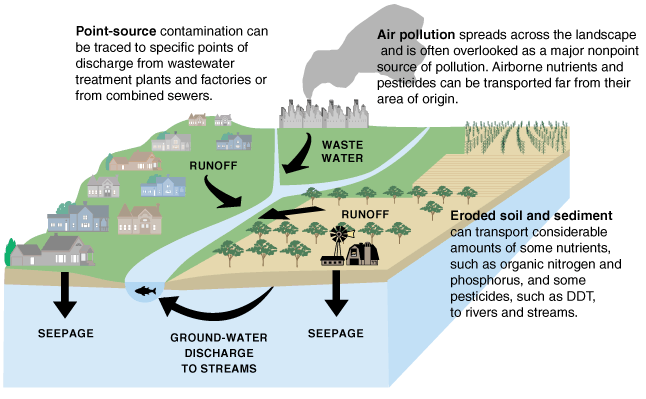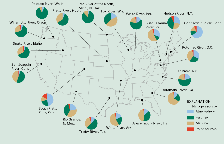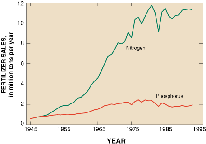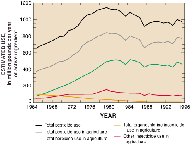
Sources of nutrients and pesticides |
U.S. Geological Circular 1225--The Quality of Our Nation's Waters--Nutrients and Pesticides
Point sources are regulated
Point sources are regulated by laws that place limits on the types and amounts of contaminants released to water. Legislation has resulted in reductions in industrial sources and upgrades to wastewater treatment plants. Although violations occur, the legislation has had a positive influence on preventing or limiting contaminants from entering water systems.
Nonpoint sources contribute more contaminants than point sources
It is more difficult to develop solutions for nonpoint sources, which are vastly more widespread and difficult to identify and quantify than point sources. For example, in the first 20 Study Units, it is estimated that about 90 percent of nitrogen and 75 percent of phosphorus originates from nonpoint sources; the remaining percentages are from point sources.
The atmosphere is a nonpoint source of contamination
The atmosphere commonly is overlooked as a source of nutrient and pesticide contamination. Yet, more than 3 million tons of nitrogen are deposited in the United States each year from the atmosphere. The nitrogen is derived either naturally from chemical reactions or from the combustion of fossil fuels, such as coal and gasoline. Local contributions also come from evaporative losses of nutrients in the vicinity of open-air manure lagoons. Nearly every pesticide that has been investigated has been detected in air, rain, snow, or fog across the Nation at different times of year. Atmospheric deposition is not evenly distributed across the United States. For example, the highest deposition rates of nitrogen (greater than 2 tons per square mile) occur in a broad band from the Upper Midwest through the Northeast.
| Assessment of the occurrence of nutrients and pesticides in water resources requires recognition of complicated interconnections among surface water and ground water, atmospheric contributions, natural landscape features, human activities, and aquatic health. The vulnerability of surface water and ground water to degradation depends on a combination of natural landscape features, such as geology, topography, and soils; climate and atmospheric contributions; and human activities related to different land uses and land-management practices. |

Nonpoint-source contamination comes from many diffuse sources, including fertilizers and pesticides from agricultural and residential lands, and nutrients from livestock and pet wastes and from septic systems. Nonpoint- source contamination starts with precipitation falling on the ground. As the resulting runoff moves over and through the soil, it picks up and carries away natural and human-made contaminants, finally transporting them to streams, rivers, wetlands, lakes, and even ground water. Nonpoint-source contamination is the leading and most widespread cause of water-quality degradation, and it can have harmful effects on drinking-water supplies, recreation, fisheries, and wildlife.
Streams, which commonly serve as drinking-water supplies, recreational areas, and biological habitats, are influenced by the landscape through which they flow and the atmosphere from which the water originates. The vulnerability of streams to contamination reflects a complex combination of upstream natural processes, land use, chemical use, and land-management practices.
Fish and other aquatic organisms reflect cumulative effects of water chemistry and land-use activities. Fish, for example, acquire some pesticides by ingesting stream invertebrates or smaller fish that have fed on contaminated plants. Fish also can accumulate some contaminants directly from water passing over their gills.
Ground water--the unseen resource--is the source of drinking water for more than 50 percent of the Nation. As water seeps through the soil, it carries with it substances applied to the land, such as fertilizers and pesticides. Water moves through water- bearing formations, known as aquifers, and eventually surfaces in discharge areas, such as streams, lakes, and estuaries. It is common to think of surface water and ground water as separate resources; however, they are interconnected. Ground-water discharge can significantly affect the quality and quantity of streams, especially during low-flow conditions. Likewise, surface water can affect the quality and quantity of ground water.
About 1 billion pounds of pesticides are applied each year
Total pesticide use in the United States has remained relatively constant at about 1 billion pounds per year, after growing steadily through the mid-1970s because of increased use of herbicides. Agriculture now accounts for 70 to 80 percent of total pesticide use. Most agricultural pesticides are herbicides, which account for about 60 percent of the agricultural use. Insecticides generally are applied more selectively and at lower rates than herbicides. Major changes in insecticide use have occurred over the years in response to environmental concerns, which have resulted in various restrictions on the use of organochlorine insecticides, such as DDT. Specifically, as the use of these persistent pesticides declined, the use of other, less persistent insecticides increased.
Commercial fertilizer and manure are important sources of nutrients
About 12 million tons of nitrogen and 2 million tons of phosphorus are applied each year as commercial fertilizer. Another 7 million tons of nitrogen and 2 million tons of phosphorus are applied as manure. The distribution of fertilizer use varies across the Nation. The highest application rates (greater than 7 tons per square mile) occur over a broad area of the Upper Midwest; other areas of high application are along the East Coast, throughout the Southeast, and in agricultural areas of the West. Private septic systems also can be important sources of nutrients in rural and residential areas.
Phosphorus contributions from laundry detergent have decreased
From about 1940 to 1970, laundry detergent was a major source of phosphorus to the environment. Contributions decreased to almost negligible amounts after the enactment of State phosphate detergent bans beginning in the 1970s and the voluntary cessation of phosphate use by detergent manufacturers.(11)
 |
||
 |
 |
|